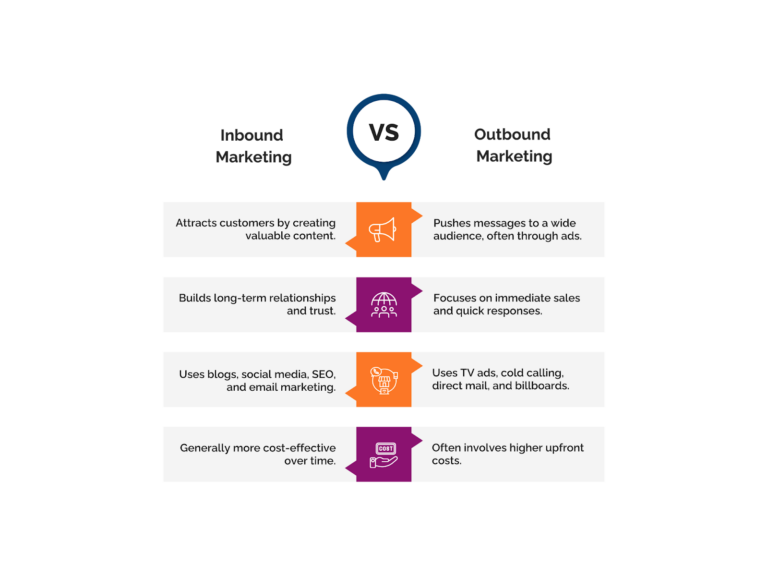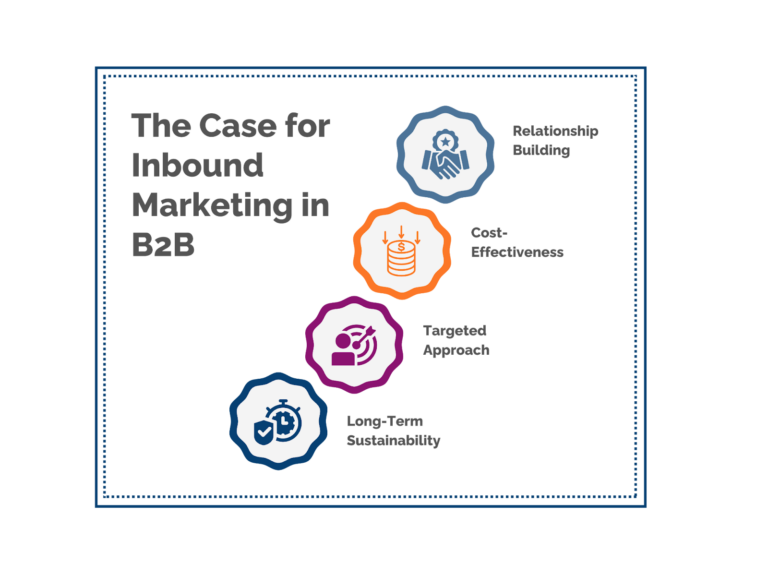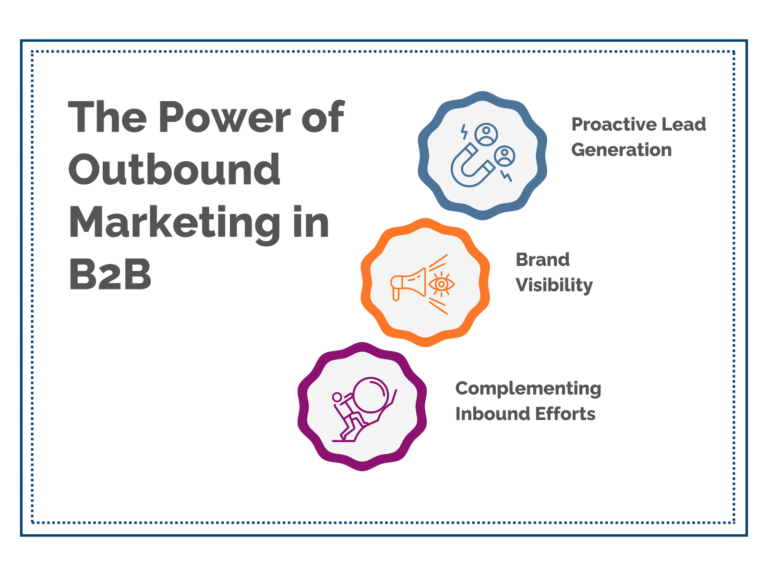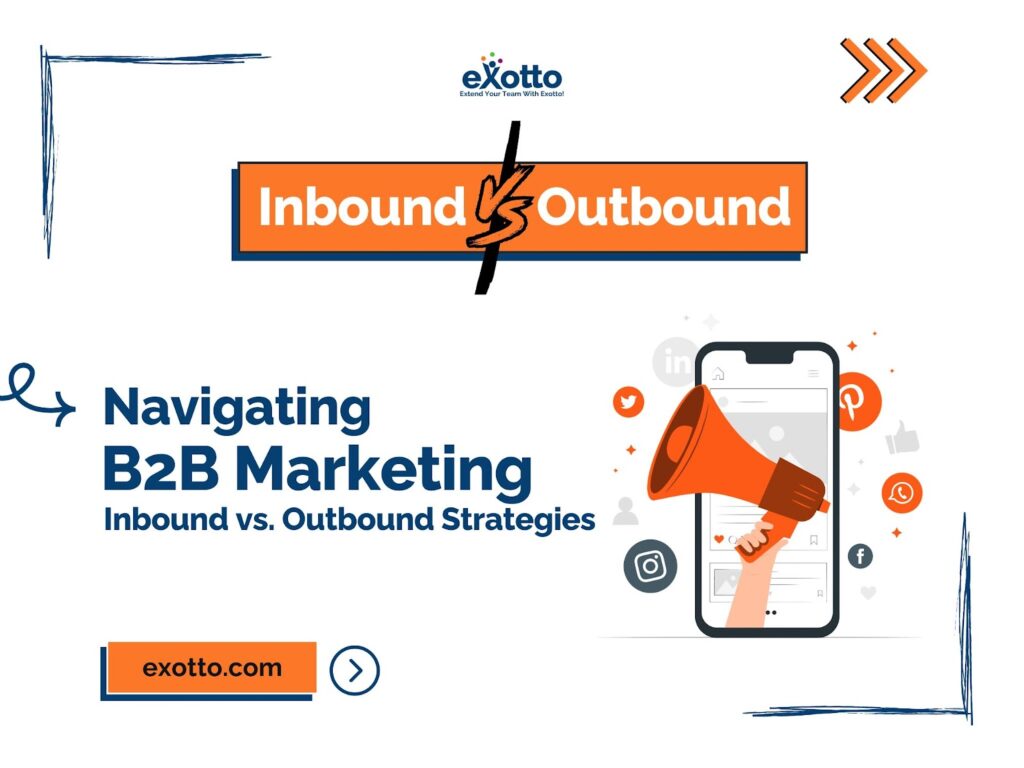In the bustling business-to-business (B2B) marketing world, where every click and conversion counts, choosing the right strategy is paramount. Two methodologies stand out: inbound or outbound marketing in this digital age. Both have their merits, but which is the best fit for B2B enterprises seeking to maximize their reach and ROI? Let’s delve into the intricacies of inbound and outbound marketing to uncover the ideal approach for B2B success.
Understanding Inbound and Outbound Marketing
While inbound marketing offers numerous benefits, outbound strategies still hold relevance in the B2B landscape.

- Inbound Marketing: Inbound marketing is about attracting prospects through valuable content and experiences tailored to their needs. It focuses on creating and sharing content that appeals to the target audience, drawing them organically towards the brand. Through tactics like SEO, content marketing, social media engagement, and email newsletters, inbound marketing aims to build trust and credibility, ultimately leading to conversions and customer loyalty.
- Outbound Marketing: On the flip side, outbound marketing involves reaching out to potential customers through traditional advertising and promotional methods. This proactive approach includes strategies like cold calling, direct mail, trade shows, and advertising campaigns. Outbound marketing casts a wide net, aiming to capture the attention of as many prospects as possible, often through interruption-based techniques.
The Case for Inbound Marketing in B2B
In B2B marketing, inbound strategies have gained considerable traction for several compelling reasons.

1. Relationship Building: B2B transactions often involve complex decision-making processes and long sales cycles. Inbound marketing fosters meaningful relationships by providing valuable insights and solutions tailored to the needs of potential clients. This approach nurtures trust and positions the brand as a thought leader in its industry.
2. Cost-Effectiveness: Compared to outbound techniques like cold calling and print advertising, inbound marketing can deliver significant cost savings. By creating evergreen content and leveraging digital channels, B2B enterprises can generate leads and engage prospects at a fraction of the cost of traditional outbound methods.
3. Targeted Approach: Inbound marketing allows B2B marketers to precisely target their ideal audience segments. Through advanced analytics and data-driven insights, businesses can tailor their content and campaigns to resonate with specific industries, job roles, or pain points, thereby increasing the likelihood of conversion.
4. Long-Term Sustainability: Unlike outbound marketing, which relies on continuous investment to maintain visibility, inbound strategies have long-term sustainability. High-quality content assets continue to attract and engage prospects over time, generating a steady stream of leads and nurturing relationships throughout the buyer’s journey.
The Power of Outbound Marketing in B2B
While inbound marketing offers numerous benefits, outbound strategies still hold relevance in the B2B landscape.

1. Proactive Lead Generation: In certain B2B industries, especially those with niche markets or high-value clients, outbound marketing can be an effective way to proactively generate leads. By reaching out directly to decision-makers through targeted campaigns, businesses can jumpstart the sales process and drive immediate results.
2. Brand Visibility: In crowded B2B sectors, where competition is fierce, outbound marketing can help brands stand out and increase their visibility. Trade shows, conferences, and industry events provide valuable opportunities for face-to-face engagement and networking, helping businesses make a lasting impression on potential clients.
3. Complementing Inbound Efforts: Rather than viewing inbound and outbound marketing as mutually exclusive, savvy B2B marketers recognize the value of integrating both approaches. Outbound tactics can complement inbound efforts by amplifying brand awareness, driving traffic to content assets, and accelerating the sales cycle for specific target accounts.
Finding the Right Balance
So, which strategy reigns supreme in the B2B arena: inbound or outbound? The truth is, there’s no one-size-fits-all answer. The effectiveness of each approach depends on various factors, including industry dynamics, target audience preferences, and budget constraints.
Instead of pitting inbound against outbound, B2B marketers should focus on finding the right balance between the two methodologies. By leveraging the strengths of both inbound and outbound strategies, businesses can create a holistic marketing ecosystem that maximizes reach, engagement, and conversions.
Partnering with a B2B Inbound Marketing Agency
For B2B enterprises looking to navigate the complexities of inbound and outbound marketing, partnering with a specialized agency can provide invaluable support and expertise. A B2B inbound marketing agency offers strategic guidance, creative execution, and measurable results, helping businesses achieve their marketing objectives with precision and efficiency.
Conclusion
The debate between inbound and outbound strategies often sparks lively discussions. However, rather than viewing these methodologies as opposing forces, B2B enterprises should recognize the value of integrating both approaches into their marketing arsenal.
Inbound marketing shines in its ability to nurture relationships, deliver targeted content, and sustainably attract leads over time. Its cost-effectiveness and focus on providing value align well with the needs of modern B2B buyers.
On the other hand, outbound marketing offers proactive lead generation, brand visibility, and the potential for immediate results, particularly in niche markets or high-value segments. When used strategically, outbound tactics can complement inbound efforts and accelerate the sales cycle.
Ultimately, the key to B2B marketing success lies in finding the right balance between inbound and outbound strategies. By leveraging the strengths of each approach and adapting to evolving market dynamics, businesses can create a comprehensive marketing ecosystem that drives engagement, conversions, and long-term growth.
Whether it’s partnering with a B2B inbound marketing agency or implementing a hybrid marketing strategy in-house, B2B enterprises must remain agile, innovative, and customer-centric in their approach.
Contact Exotto today and start working on these strategies for your business growth!
Key Points
- Attracts leads through content and SEO, fostering trust and long-term relationships.
- Proactively reaches prospects via ads and direct outreach, generating quick leads.
- Combining both strategies often yields the best results for B2B businesses.

